
The vineyards of Bourgogne produce some great wines with a historical and international reputation. However, the region is not simply limited to its iconic appellations. In addition to its Village Premier Cru and Grand Cru AOCs, it also produces a range of wonderful Régionale and Village appellations to explore.
You will also find a full list of the Bourgogne’s Climats and lieux-dits on this page.
Check out the complete list of the 84 Bourgogne appellations.
However, your exploration has only just begun. Bourgogne wines have never before offered such high quality. Besides our range of internationally celebrated wines, try some of our lesser-known appellations where there are lots of surprises in store.
And for a fun way to find out more about the wines on offer, try out our “Which Bourgogne wine is right for me?” quiz, or check out Bourgogne Maps to take an interactive tour of the region.
Regional Appellation
VIGNOBLE DU MÂCONNAIS
White: Chardonnay
Area under vine: 33 hectares
Note: Average over three years 2016-2018
An additional geographical denomination that is part of the Régionale Mâcon appellation in the Mâconnais. According to the 2005 specifications rules, the name Mâcon-Vinzelles refers to white wines grown within a defined area in the village of Vinzelles.

A lovely pale gold color with hints of silver, Mâcon-Vinzelles wines are characterized by their generous fruitiness with aromas of yellow-fleshed fruits like pêche de vigne and apricot, with hints of acid candy. But despite this clear opulence that is inherent to the southern location of the vines from which it is made, this is still a dry wine that opens with a forthright approach. In the mouth, the charm is evident – there is a fattiness, but this is balanced by a light acidity.

With its sunny aromatic character and smoothness on the tongue, this wine makes a natural pairing with all kinds of goat cheeses, such as the traditional AOC Mâconnais or its neighboring Charolais for a terroir-themed aperitif. Follow with grilled chicken supremes or mixed fried river fish. This white wine will also bring out the best in local freshwater fish dishes, such as carp with white wine, or pochouse from Verdun-sur-le-Doubs.
Serving temperatures: 10-11°C as an aperitif, 11-12°C with food

To the south of the Petite Grosne, the Mâcon-Vinzelles appellation is found between the Mâcon-Loché AOC to the north and Mâcon-Chaintré to the south. To the west, the houses in the village center mark the beginning of Pouilly-Vinzelles.
Looking down over the valley of the Saône river, Vinzelles has a name that speaks volumes. The Latin word “vincella” means “little vine” and this was one of the first strategic fortresses of the King of France after 1172.
The Château de Layé replaced the former military chateau and in the 17th century, became the center of a large winegrowing estate, whose huge presses from 1716 can still be seen today. This style of press with a reinforced lever is specific to the Mâconnais region, and other examples can be seen in Solutré. They became popular in this part of Bourgogne from the 17th century onwards. Back then, the village’s winegrowing economy had been around for a long time.
As far back as 1510, under pressure from winemakers determined to save their harvest, the ecclesiastical judge of the bishopric of Mâcon announced the excommunication of caterpillars ravaging the vines!

Located on the lower part of a long and gentle east-facing slope, the vines of Mâcon-Vinzelles face the main highway to the south at between 190-220 meters above sea level at the church. Thanks to a southerly influence, the climate here reveals some of the highest average summer temperatures and cold, rainy continental winters with around 800mm of precipitation annually. Fog is less of a feature here.
While the Pouilly-Vinzelles AOC occupies the upper part of this well-drained hillside with red limestone substrate from the Bajocian, dating back between 165-170 million years, the vines of Mâcon-Vinzelles grow on much more recent formations from the Quaternary (2.5 million years ago), namely pebbly scree from the erosion of the Bajocian slope combined with clay. The soil is much deeper here.
At the heart of the terroirs of Mâcon-Vinzelles
